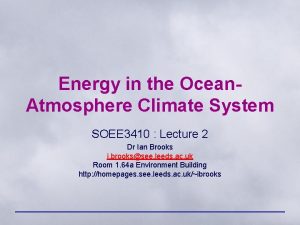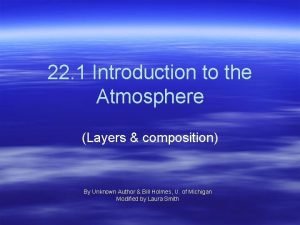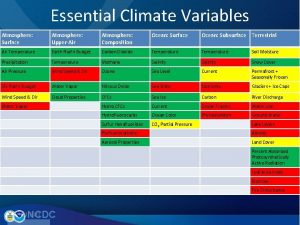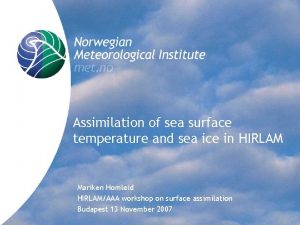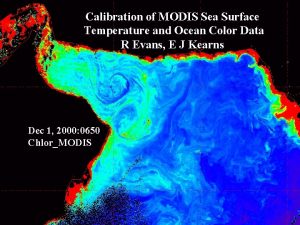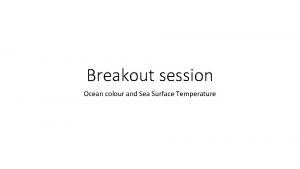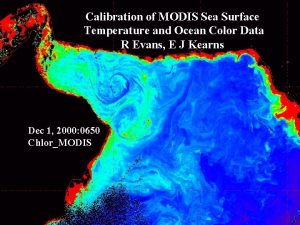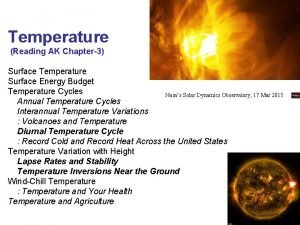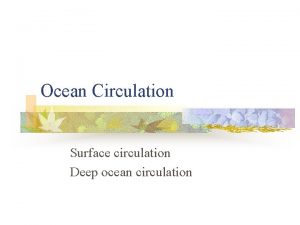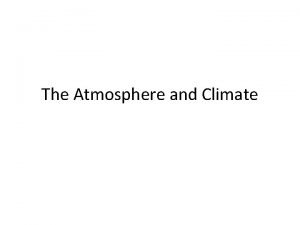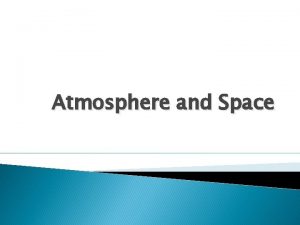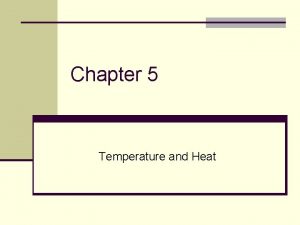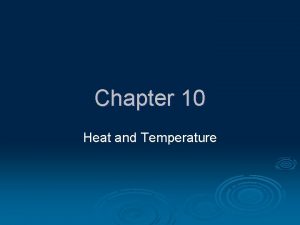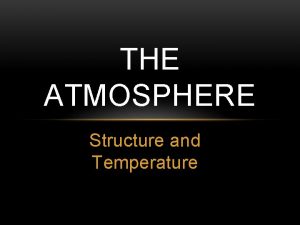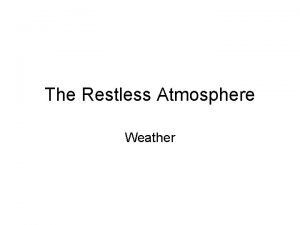Chapter 9 Sea Surface Temperature Ocean and atmosphere




















- Slides: 20

Chapter 9

Sea Surface Temperature Ocean and atmosphere Stability Net surface radiation flux Surface heat fluxes Sensible and latent heat Coupling Salinity Processes Energy transfer Heat transfer by Precip. Storage and transport of energy below the ocean

Just one example… Do we need coupling and fluxes? ? Processes in the interface permit interaction each time step

Removing heat Ocean Surface Energy Budget Net surface radiation flux Latent heat Sensible heat Heat transfer by precipitation Ocean Transport of energy via fluid motions Storage Transport of energy via fluid motions Via entrainment Adding heat

Surface turbulent heat fluxes High-frequency measurements Sensible heat flux Rarely available Latent heat flux Covariances Estimate in terms of other parameters Bulk aerodynamic formulae Near-surface turbulence arises from the mean wind shear over the surface Turbulent fluxes of heat and moisture are proportional to their gradients just above the ocean surface

Surface turbulent heat fluxes Bulk aerodynamic formulae Aerodynamic transfer coefficients Under Ordinary conditions Stable Neutral unstable Just above the surface Richardson number

Aerodynamic transfer coefficients Stable Neutral unstable Small for statically stable conditions Large for unstable conditions The magnitude of the heat transfer is inversely proportional to the degree of stability

Heat flux for precipitation Temperature of the rain drop heat transfer occurs if the precipitation is at different temperature than the surface !!! If thermal equilibrium Train= wet bulb T of the atmosphere Greatest for large rainfall rates and large differences in temperature Usually Snow? ? Heat flux from rain cools the ocean Long term contribution to surface energy budget small Commonly Neglected Latent heat Melt Snow The latent heat is an order of magnitude larger than sensible heat term

Variation of surface energy budget components Bowen Ratio

Ocean Surface Salinity Budget Precipitation Evaporation Formation of sea ice Melting of sea ice River runoff Storage transport below the ocean surface mm/yr Important regional differences Artic Ocean 97 53 Atlantic Ocean 761 1133 Indian Ocean 1043 1294 Pacific Ocean 1292 1202 All Oceans 1066 1176

P-E average 1959 -1997

Global river runoff Fresh-water input to the southern oceans comes from melting

Ocean Surface Buoyancy flux Negative value meets the instability criterion Sinking motion in the ocean Evaporation Increases the buoyancy flux Ratio of the cooling term to the salinity term of evaporation Precipitation Tropics T=30 C; s=35 psu 8. 0 High latitudes T=0 C; s=35 psu 0. 6 decreases and increases the buoyancy flux Freshening effects of rain dominate the cooling effects of rain at all Snow latitudes Freshening dominates the effect on the buoyancy flux

Ice/ocean Heat flux terms that influence the surface Penetration of solar radiation beneath the ice Latent heat associated with freezing or melting ice Sea Ice grows Typical polar conditions Salinity term dominates in determining ocean surface buoyancy flux Increase salinity releases latent heat

large body of air that has similar temperature and moisture properties throughout. Air mass Source regions The best for air masses are large flat areas where air can be stagnant long enough to take on the characteristics of the surface below uniform surface composition - flat light surface winds The longer the air mass stays over its source region, the more likely it will acquire the properties of the surface below. Once an air mass moves out of its source region, it is modified as it encounters surface conditions different than those found in the source region. For example, as a polar air mass moves southward, it encounters warmer land masses Classification: Tropical (T) By thermal properties Polar (P) Continental (C) By moisture Artic or Antarctic (A) Also Cold (K) Warm (W) Maritime (m)

Continental Arctic (c. A): Extremely cold temperatures and very little moisture. originate north of the Arctic Circle, where days of 24 hour darkness allow the air to cool very rarely form during the summer Continental polar (c. P): not as cold as Arctic air masses form during the summer, but usually influence only the northern USA Cool and moist Maritime polar (m. P): Maritime tropical (m. T): Continental Tropical (c. T): form over the northern Atlantic and the northern Pacific oceans can form any time of the year and are usually not as cold as continental polar air masses. Warm temperatures and moisture originate over the warm waters of the southern Atlantic Ocean and the Gulf of Mexico can form year round Hot and very dry usually form over the Desert Southwest and northern Mexico during summer


Water mass Two basic circulation systems in the oceans the wind-driven surface circulation the deepwater density-driven circulation Only about 10% of the ocean volume is involved in wind-driven surface currents. The other 90% circulates due to density differences in water masses Water masses are identified by their temperature, salinity, and other properties such as nutrients or oxygen content. Different inputs of freshwater all water masses gain their particular characteristics because of interaction with the surface during their development. Patterns of precipitation Evaporation temperature regimes Once water masses sink, their temperature and salinity are modified primarily by mixing with other water masses (diffusive and turbulent heat exchange). process is very slow

Water mass surface water 0 -200 meters their names generally incorporate information about the depth levels they occur at intermediate water 200 -1500 meters deep water 1500 -4000 meters bottom water deeper than deep water North Atlantic Deep Water forms in the region around Iceland. North Atlantic Intermediate Water has come near the surface and has been cooled by the contact with the air. Mediterranean Outflow Water is a deep water mass that results from high salinity, not cooling. Antarctic Bottom Water is the most distinct of all deep water masses. It is cold (-0. 5°C or 31. 1°F) and salty (34. 65 parts per thousand).

 Chapter 15 ocean water and ocean life answer key
Chapter 15 ocean water and ocean life answer key Ocean atmosphere and climate
Ocean atmosphere and climate Ocean atmosphere and climate
Ocean atmosphere and climate 4400x12
4400x12 Difference between curie temperature and neel temperature
Difference between curie temperature and neel temperature Difference between curie temperature and neel temperature
Difference between curie temperature and neel temperature Ferrimagnetism
Ferrimagnetism Divergent vs convergent plates
Divergent vs convergent plates Ocean ocean convergent boundary
Ocean ocean convergent boundary Ocean to ocean convergent boundary
Ocean to ocean convergent boundary Ocean ocean convergent boundary
Ocean ocean convergent boundary Crack watc
Crack watc Ocean to ocean convergent boundary
Ocean to ocean convergent boundary Blue og red ocean
Blue og red ocean What is asias largest desert
What is asias largest desert What does the sea symbolize in the old man and the sea
What does the sea symbolize in the old man and the sea Earth surface atmosphere
Earth surface atmosphere Psychology
Psychology Led soldiers across hellespont into anatolia
Led soldiers across hellespont into anatolia Hydra coral
Hydra coral Sea stack sea arch
Sea stack sea arch


